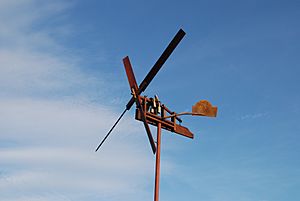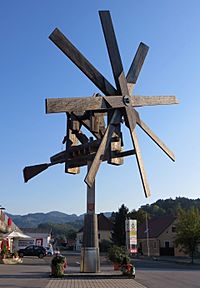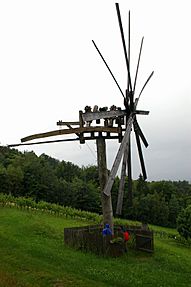Klopotec facts for kids
A klopotec is a special wooden machine that stands on a tall pole. It looks a bit like a windmill. People use klopotecs in vineyards to scare away birds, especially starlings. This helps protect the grapes. You can find these unique devices in places like Slovenia, Austria, and Croatia. The klopotec is even a symbol of Slovenia and a region called Styria.
The way a klopotec works is pretty cool! It has blades, like a windmill, that spin in the wind. As the blades turn, they move an axle. This axle has wooden hammers attached to it. When the axle spins, the hammers lift up and then fall back down. They hit a wooden board, making a rhythmic rattling sound. The sound helps to scare birds away from the tasty grapes. The type of wood used for the hammers and board changes the sound. The number of hammers and how fast the wind blows change how quickly it rattles.
People mainly use klopotecs to keep birds from eating the grapes. There's also an old belief that klopotecs can scare away snakes and even make the grapes softer! Sometimes, in old church music, the sound of a klopotec is even used like a musical instrument.
Contents
What's in a Name?
The klopotec has different names depending on where you are. In the Slovene language, it's called klopotec. Some people also call it klapoc. Both these words come from klopotati, which means to make short, rhythmic sounds.
In the German language, it's often called Windradl. You might also hear the words Klapotetz or Klapotez. In English, you could describe it as a bird-scaring rattle, a wind-rattle, or a wind-clapper.
A Look Back in Time
No one is completely sure when the klopotec first appeared. Some historians think it might have been used in the 1500s in certain areas. However, many experts believe it became popular during the Age of Enlightenment, a time when new ideas were spreading.
A common idea among ethnologists (people who study cultures) is that the bird-scaring rattle started in Slovenia. Another idea suggests it was first used by the French in the 1700s.
The first time the klopotec was written about was in the late 1700s. The oldest pictures of it are from the early 1800s. A famous poem from 1797, called Lamentation of a Winedresser, even mentions the device. A very important person, Archduke Johann of Austria, had a klopotec in his vineyard in 1836.
It's also possible that similar devices, called Klappermühle, were mentioned in German writings as early as the 1500s. These might have been true mills or smaller wind-powered rattles.
How a Klopotec Is Built
A klopotec is made of several different parts. To make the best sound, each part should ideally be made from a specific type of wood. The wood used for the hammers and the board is super important. The right combination helps create a special sound that scares birds away.
Here are the main parts:
- stolček (block) - This part holds the main axle. It's usually made from strong wood like chestnut, oak, or ash.
- kvaka (axle) - This is the central rod that spins. The hammers are attached to it through drilled holes.
- macleki (hammers) - These are the pieces that hit the board. They should be set up so only one hits at a time. Beechwood is often the best wood for these.
- deska (board) - This is the wooden board that the hammers strike against. It's often made from chestnut or cherry wood.
- viličice (little forks) - These small parts hold the hammers in place. They are usually made from oak or beech.
- verižica (chainlet) - The board hangs from this small chain.
- rep (tail) - This part helps the klopotec turn to face the wind. It can be made from oak or pine branches, as their leaves stay on for a long time. An old broom can also be used!
- vetrnica (sail) - This is the part that spins in the wind, like a windmill blade. It transfers the wind's power to the axle. It's often made from poplar or fir wood. The number of blades can be different depending on the region.
- zavora (brake) - Some very large klopotecs have a brake. This stops them from spinning too fast in strong winds.
One of the biggest klopotecs is on the Demmerkogel mountain. It's 16 meters (about 52 feet) tall! Its moving parts weigh 3.4 metric tons, and each of its eight hammers weighs 40 kilograms (about 88 pounds).
Klopotec Traditions
You'll hear the klopotec most often in areas that grow white wine. This includes parts of Southwest Styria and Eastern Slovenia, like the Slovene Hills and Haloze. It's also found in some parts of Croatia.
Traditionally, klopotecs are put up around July 25th (Saint James's Day) or August 15th (Assumption Day). They are usually taken down after the grape harvest, by November 1st (All Saints Day) or no later than November 11th (Saint Martin's Day). If someone forgets to take their klopotec down, young people from the village might "steal" it. They then leave a message asking for a "ransom" to get it back!
Some klopotecs are decorated with small carved figurines. In the past, they were always made completely from wood. But now, it's becoming more common to see them with some metal parts.
Klopotec as a Symbol
The klopotec is an important symbol in Slovenia and its culture.
- In 1997, the Post of Slovenia even put a klopotec on a postage stamp! It was part of a collection called "Slovenia - Europe in Miniature."
- There's an annual meeting for Slovenian folk musicians called Veseli klopotec, which means "Happy Klopotec."
- An organization that protects copyrights for composers gives out an award called Zlati klopotec ("Golden Klopotec"). This award goes to the best popular song in a Slovene dialect each year.
See also
 In Spanish: Klapotetz para niños
In Spanish: Klapotetz para niños




